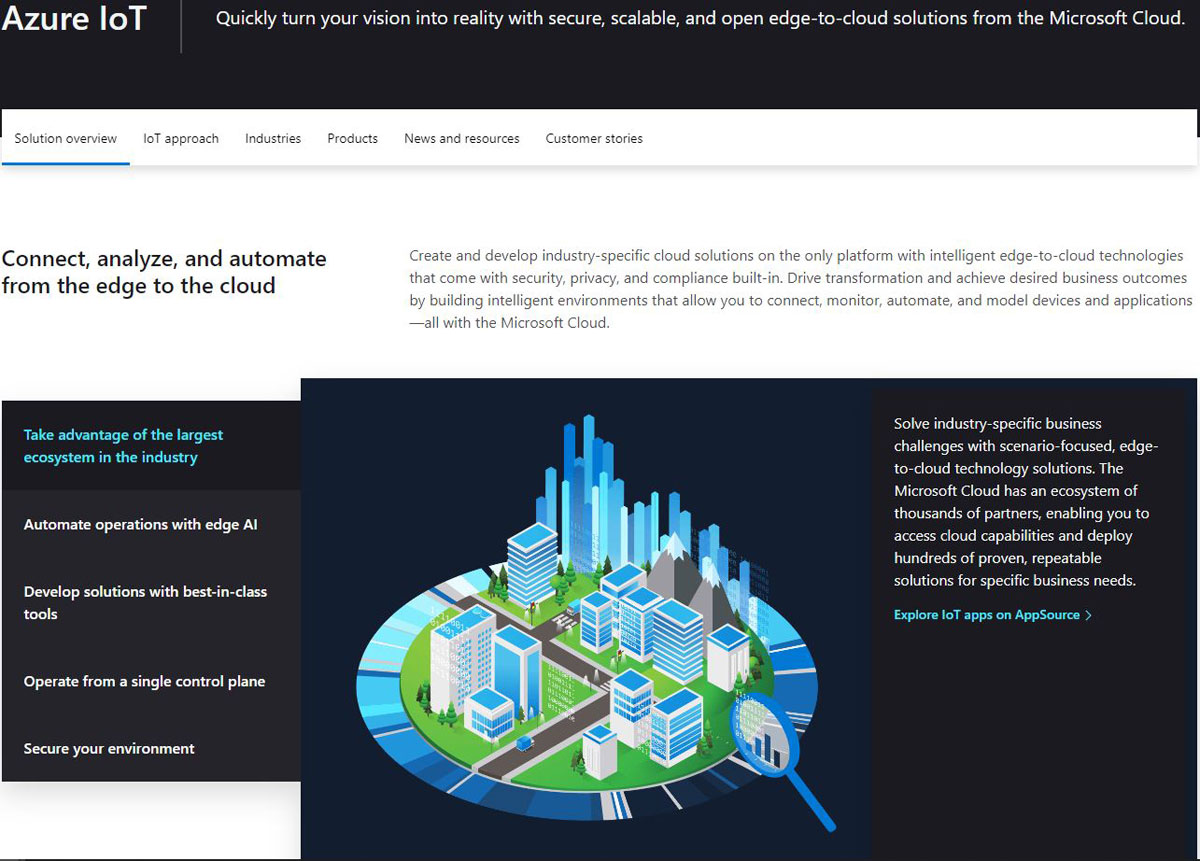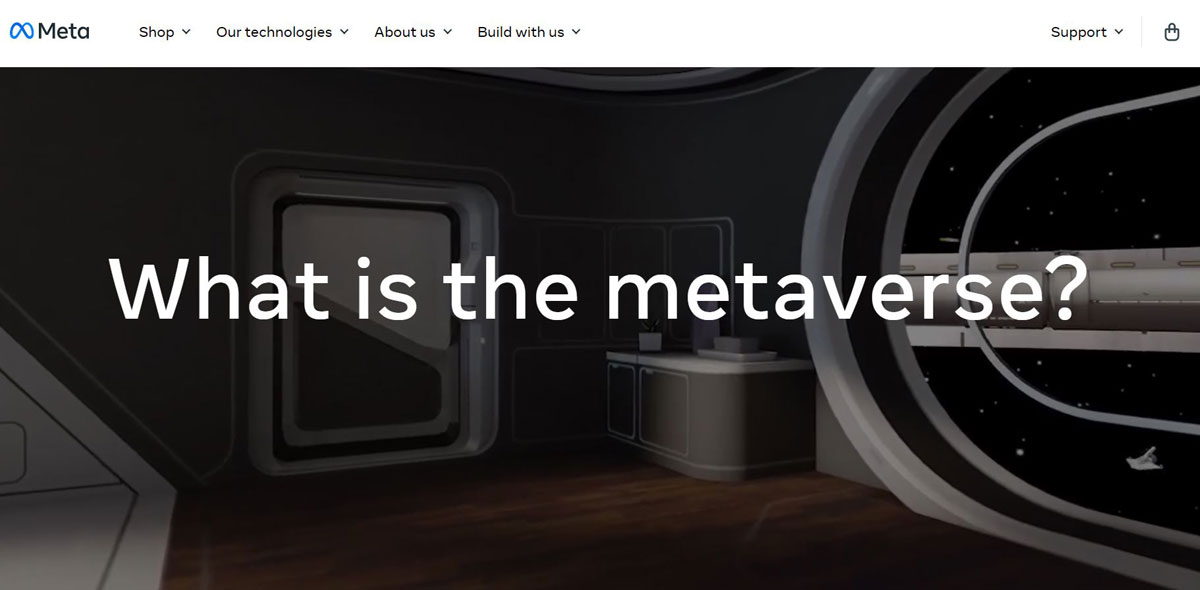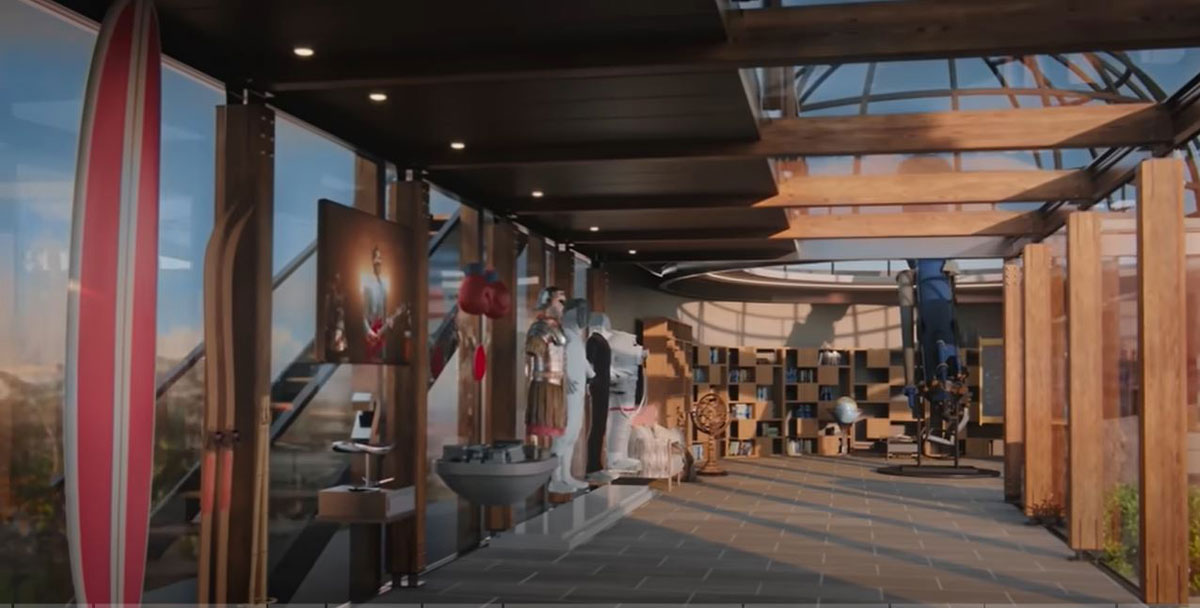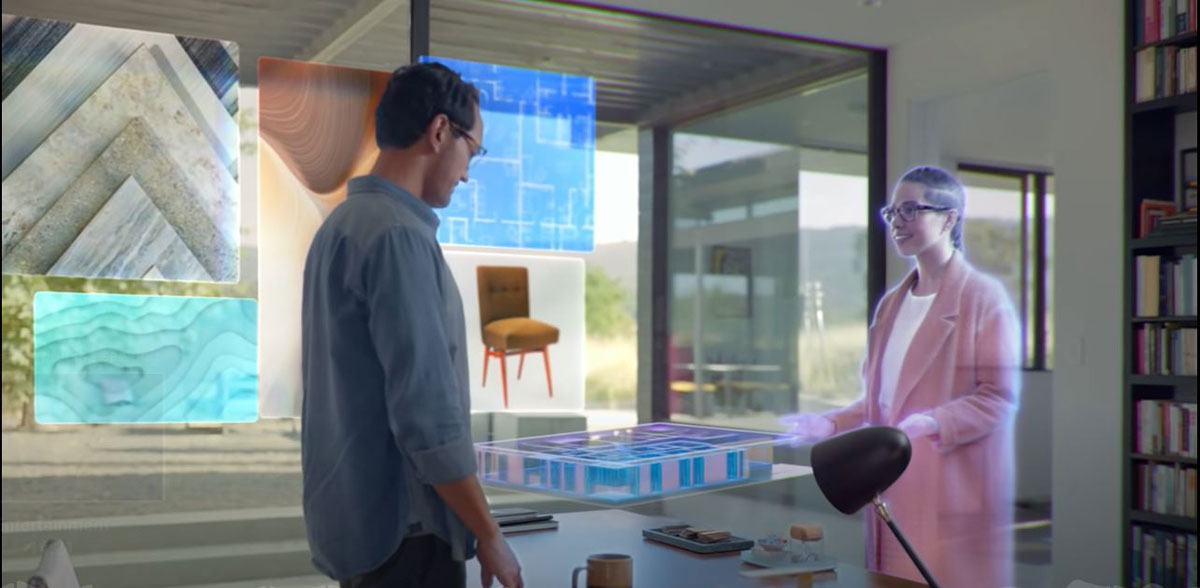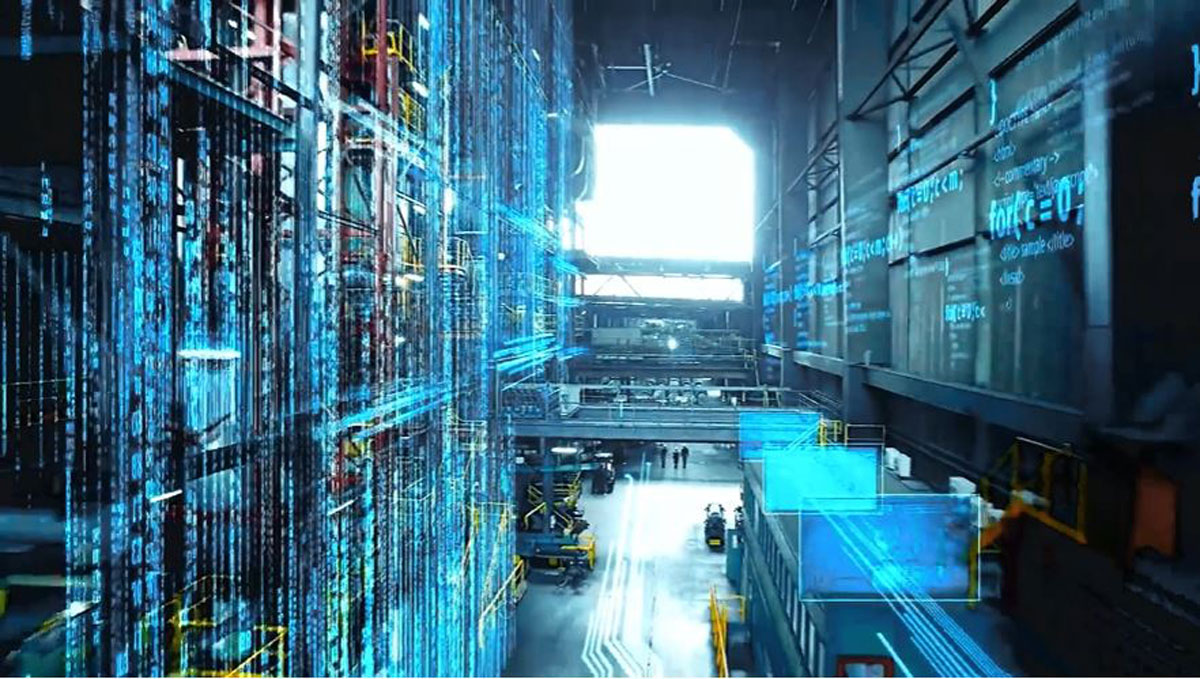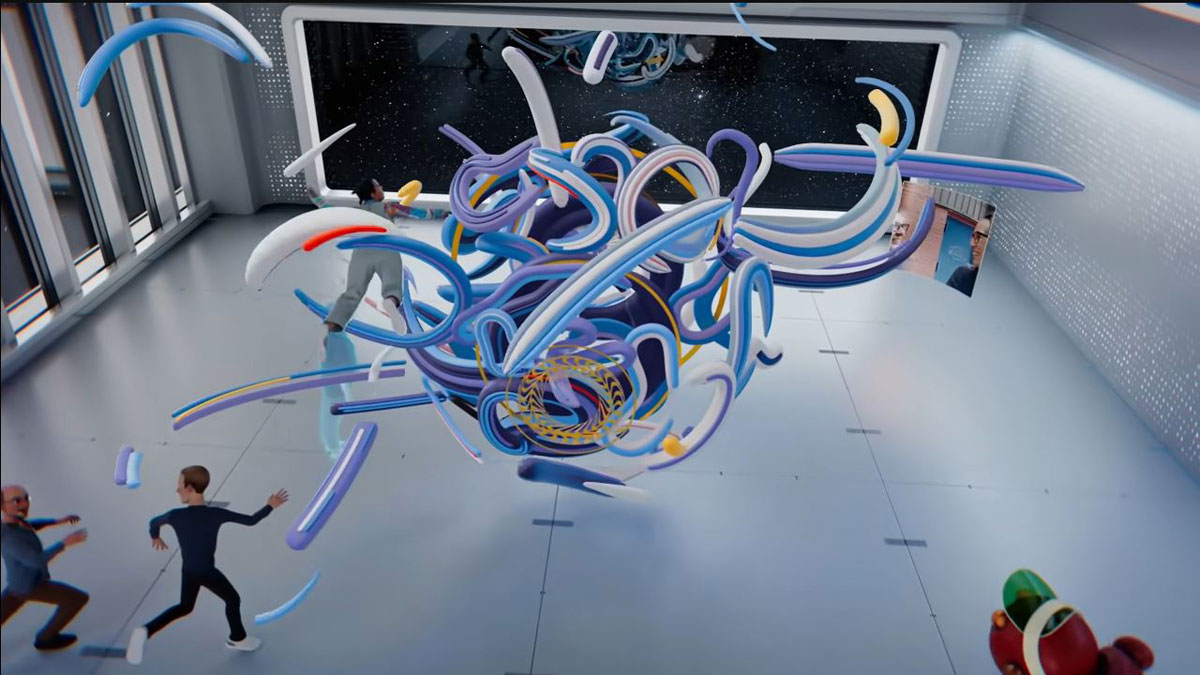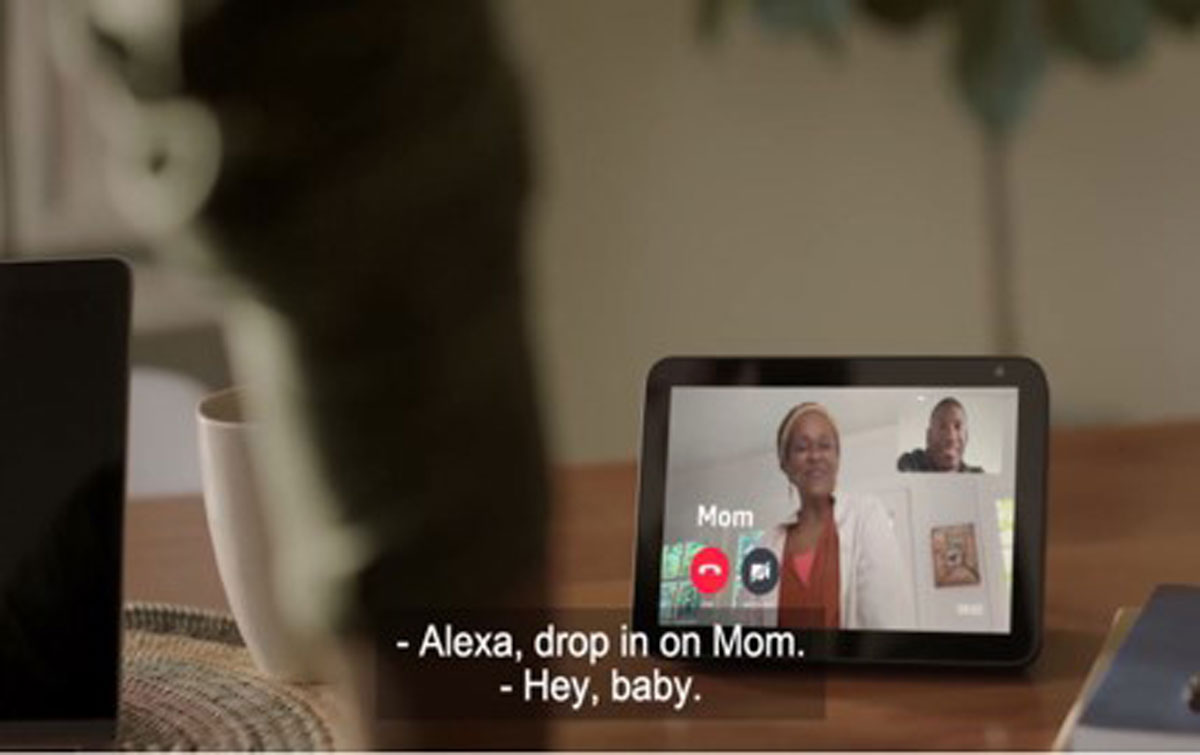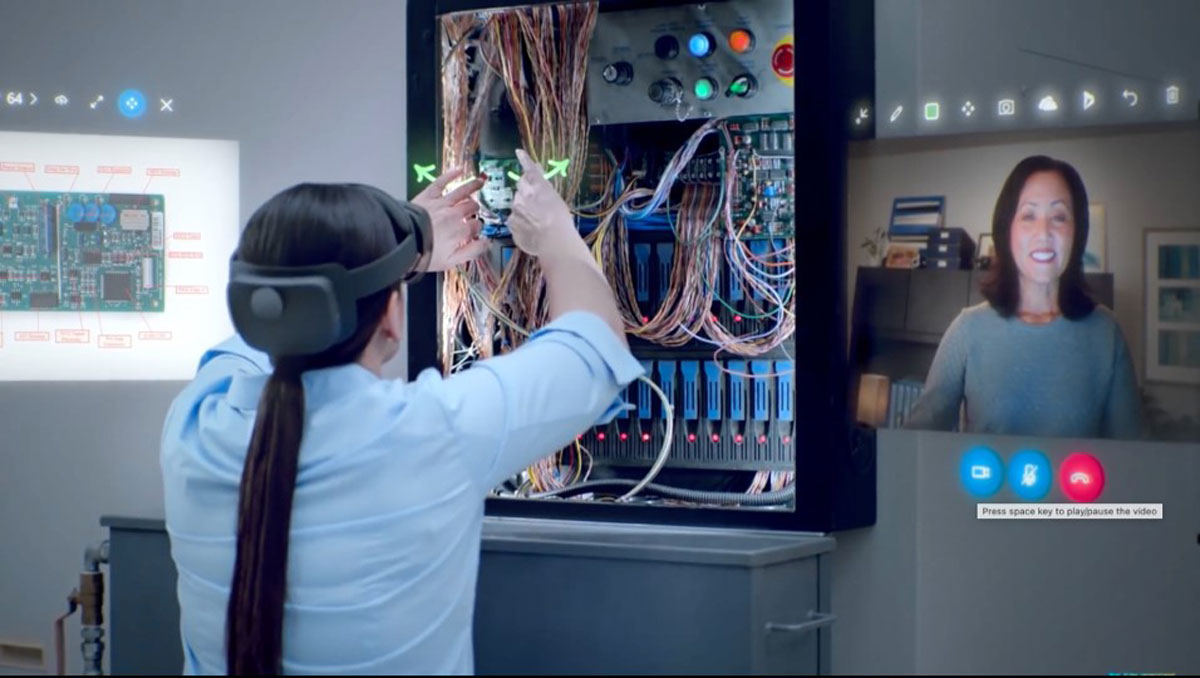1. Introduction
This paper’s subject is the growing presence of ubiquitous interfaces in the promotion of new digital services by Big Tech companies. These new interfaces, also called ambient, augmented reality (AR), virtual reality (VR), or mixed reality, differ from previous generations of human-machine interfaces, normally envisioned as discrete screens, buttons or surfaces (Bratton, 2016). Instead, interfaces come to be understood as any form of relation between different entities (Hookway, 2014); accessible from any place, through any medium—touch, voice, gesture and so on—and projected onto any surface. We claim that in tech companies’ promotional materials, these interfaces serve to narrativise and normalise the adoption of new digital services as an experience of sensorial enrichment. Our critique focuses on the ways in which such a narrative implies an intermingling of human and machine vision, where the former becomes dependent on the latter.
Even though promotional media are created as uncritically positive representations of the products they promote, they can ground the critique of tech companies’ imaginaries and narratives. As Natale, Bory & Balbi (2019) have described, ‘the launch of new products is often the most adequate stage for digital media corporations to narrate and frame themselves as key agents in ongoing changes’ (332). By marketing their digital goods, tech companies justify and normalise the specific relations they wish to establish between their users and their infrastructures. These infrastructures are often referred to as digital platforms whose financial model depends on data extraction (Van Dijck, Poell & De Waal, 2018). We claim that the promotional representation of ubiquitous interfaces—regardless of how realistic this representation is—has a strategic function in the ongoing expansion of digital platforms. The process of expansion, through which platform infrastructures eventually become vital to the functioning of technological systems, companies, and even entire societal sectors, has been conceptualised as platformisation (Helmond, 2015; Plantin et al., 2018).
For this paper, we have selected three examples of promotional materials advertising digital services, belonging to some of the largest platforms in the North American market: Amazon’s Alexa Together service, Microsoft’s Azure Internet of Things service, and Meta’s Metaverse. Each company foregrounds a promise: they will help a user or business ‘provide support’ (Amazon, 2021), ‘connect, analyze and automate’ (Microsoft, 2021) or ‘connect, work, play, learn, shop’ (Meta, 2022). Our selection allows us to address the symbolic role of ubiquitous interfaces in introducing vastly different products for equally different audiences. We frame these promotional materials as elements in the discourses of platforms: the production of visual, textual and digital media through which these companies intervene in public discourse, promoting values and visions which justify the ongoing platformisation of everyday life.
We aim to make two contributions to existing literature: one methodological and one theoretical. Methodologically, we highlight promotional materials (visual, in particular) as a key archive in the study and critique of platform discourses. We situate ourselves within a growing critical corpus that frames Big Tech discourses as strategic interventions in public debates surrounding the socio-economic role of digital platforms (e.g., Gillespie, 2010; Hoffmann, Proferes & Zimmer, 2016; Nieborg & Helmond, 2018; Natale et al., 2019). Focusing on promotional materials provides insight into the envisioned relationships between the products, their technical components (including interfaces), and their human users. In this paper, we study the degrees to which human vision is represented as dependent on techniques of interfacial visualisation, and the type of user this implies.
This methodological contribution is linked to our theoretical intervention, at the intersection of interface studies, platform studies and cultural studies. We frame promotional materials as part of the cultural production of platforms, in which interfaces come to play a key symbolic role. Platform companies are not just infrastructures which influence or organise the production of culture (Poell, Nieborg & Duffy, 2021), but are also themselves cultural producers. Platformisation, we argue, is as much a process of culture as it is of infrastructures and policies. Focusing on the cultural production of platforms, we address the discursive processes that frame users as datafied subjects (Cheney-Lippold, 2017). This is done by framing modes of data expropriation as opportunities for sensorial enrichment, while obfuscating the computational processes through which they take place. Following Orit Halpern, we situate our objects of study within the ongoing negotiation and restructuring of human vision, for which data and digital media become ever more central (Halpern, 2015). Like the analysis of Zuckerberg’s discursive construction of the user by Hoffman et al. (2016), we study the imagined user and their use of recent technologies in promotional materials.
We claim that, more than a negotiation of human vision, ubiquitous interfaces and their represented usage imply a sensorial dependence of the human on machine vision. We build on the critical analysis by media theorist Sun-ha Hong (2020), who outlines how human sense and intelligence are framed as secondary or inferior to digital systems for data extraction and processing. This hierarchical stratification leads to a regime which he defines as ‘machinic sensibility’. With reference to Hong, we coin the term ‘machinic visibility’ to describe both the capacity of interfaces to visualise data, making it perceivable for humans, and the human dependence on these visualisations. Narratives of machinic visibility, we argue, interpellate users as precarious subjects, whose daily life is dependent on platform infrastructures and vulnerable to shifts in these platforms.
The paper begins with a presentation of each case study—the services, their technical components, and the audiovisual materials involved in their promotion—situating our analysis within the context of platformisation and its critique. We analyse the audiovisual promotional materials for these products, focusing on how space is occupied by different physical devices and people, how represented interfaces mediate relations between humans and machines, how realistic and pertinent these interfaces are for the promoted services, and the overarching promises these services claim to fulfil for their users. We then question what is obfuscated by the interface’s ubiquity; namely, how the blurring of human and machine vision normalises machinic visibility and, with it, human dependence on platform infrastructures. The paper concludes with the implications of our findings for future studies of platform discourses and interfaces.
2. Case Study Selection and Methodology
We have selected three case studies of platform media to analyse how ubiquitous interfaces are currently promoted for different audiences. The first service is Amazon’s Alexa Together, released in 2021, catering for caregivers and their elderly family members. The second case study is Microsoft’s Azure cloud service, released in 2010, and specifically its Internet of Things products. The third case study is Meta’s Metaverse, released in 2021, a project that was, for its first years, heavily funded and promoted by the company. For all case studies, we focus on the websites where the services are presented and the videos in which the companies expand on the benefits of these services. To facilitate comparative analysis, we restricted our analysis to the three websites and videos, as they were available at the time of the Metaverse launch in late 2021. In the case of Alexa Together and Azure, we analyse a two-minute promotional video. In the case of the Metaverse, we analyse an 80-minute keynote. In what follows, we introduce and situate the three case studies, after which we explain our analytical approach.
2.1 Case Studies
Alexa Together, released in late 2021, is a paid subscription-based service that allows caregivers to remotely track and monitor their elderly wards. This can be done through different software and infrastructural services, such as dedicated apps, video calls and 24/7 call centre support. Central to this service is Amazon’s digital voice assistant Alexa: a voice-user-interface (VUI) system, available since 2014. Therefore, in the case of Alexa Together, the service offered is mostly an interface. It is the interface which connects different devices—from Amazon’s own Echo smart speakers to third-party devices such as fall and motion detectors—and provides reminders, connects to different services, and gives instructions to both caregiver and ward. Promotional material for Alexa Together can be found on a dedicated webpage within Amazon’s website (Figure 1). The webpage includes texts, photographs and iconographic images, a short promotional film, and links to products also purchasable through Amazon’s platform. The video, featured on the product’s website, comprises different short vignettes showing interactions between users and the Alexa interface.
Impression of the Alexa Together product page. Screenshot by the authors, January 2023. Available at: https://us.amazon.com/Alexa-Together/b?node=21390531011.
Azure is the cloud computing service that has been offered by Microsoft since 2010. Azure offers a range of cloud-based products with infrastructural services for corporate clients, including private companies such as Volkswagen, as well as governmental institutions. Azure offers a large set of data tools, including applications, cloud storage and analytical software, which are available to companies developing their own data infrastructures for different ends, such as managing workers or restructuring supply chains. Microsoft has created a large website for Azure with separate pages describing assorted products and solutions to fit different client needs. The webpage we focus on, the largest and most media-rich, presents the category of solutions that centre Azure Internet of Things (IoT) services. It comprises texts, images and graphics. From 2021 onwards, the page includes a short promotional video that shows how companies and their employees benefit from Azure IoT services (Figure 2). Notably, even though the video presents IoT services, such as digital twins, these are visualised as AR-enabled services, with video calls, 3D maps and interfaces overlaying physical reality. This leads us to frame this short video as a more general advertisement for cloud services and the Azure service package as a whole.
Impression of the Azure main product page. Screenshot by the authors, January 2023. Available at: https://azure.microsoft.com/en-us/solutions/iot/#overview.
Meta’s Metaverse is a platform that aims to connect different users, from producers and consumers of digital goods, to corporations and institutions. The platform was accessible via already existing material products—the different models of Oculus and Metaquest VR devices. However, issues with different stakeholders, floundering user numbers, and development obstacles, led the project to suffer continuous rounds of divestment as early as late 2022 (Delouya, 2022). By mid-2023, news outlets went so far as to declare the Metaverse a complete failure (Naughton, 2023). Nonetheless, as of August 2023, Metaquest devices are still sold, and the Metaverse itself is still promoted by the company, inviting new users to become part of the platform. Most of the promotional materials for this platform can be found on the company’s website, particularly through the Meta Connect website that includes recordings of different keynotes and promotional films, as well as texts, photos and graphics (Figure 3). The promotional film we analyse was made in 2021, released in lieu of Facebook’s cancelled annual conference during the Covid-19 pandemic (Meta, 2021). However, this film was never hosted on the Meta Connect website, but rather on Meta’s profile on the YouTube platform. The video takes the form of a keynote, with Zuckerberg and other Meta employees demonstrating the potential of the Metaverse for connecting users and accessing virtual worlds.
Impression of the Metaverse homepage. Screenshot by the authors, January 2023. Available at: https://about.meta.com/what-is-the-metaverse/.
2.2 Situating the Case Studies
The promotional materials for these three services target distinct audiences through different genres of audiovisual media. Amazon’s Alexa Together is clearly targeted at individual clients, while Microsoft’s Azure targets businesses of different sizes. The Metaverse has a much vaster and more ambiguous target; it addresses individual consumers, potential investors, companies looking for new digital work environments, and programmers and designers of digital goods. This in turn leads to a difference in scope for the promotional audiovisual materials; the first two cases comprise short videos, while the Metaverse presentation is a feature-length production. Furthermore, the first two videos can be understood as classic ads, focusing on a specific product and its benefits, while the third is a filmed keynote—a staged, embodied genre of communication, with the presence of different corporate representatives of the company, including Zuckerberg (Wenzel & Koch, 2018). The variation in our selected case studies allows us to track platformisation in different societal sectors, from leisure to healthcare; at different scales, from the individual to the corporate.
At the same time, the case studies allow us to compare how three prominent tech companies market their products as a new stage in human-computer interaction, emphasising its visual potential. A central element of these promotional materials is their representation of ubiquitous interfaces and the different interactions they make possible for their human users. These interactions promote different narratives of optimisation of a user’s life or a business’ performance through platform services. This is important to this paper, as interfaces play distinct roles in each case study. With Alexa, for example, the interface is the service, whereas with Azure the interface serves a more representational role in making the service visible. We therefore approach interfaces not so much as technical elements and systems, but more as strategic representations of different interactions between users and platform infrastructures (Hookway, 2013). Ubiquitous interfaces play a symbolic role in shaping the public imagination of what a platform is and what it does or does not do (Gillespie, 2010).
Here, it is important to remark on the global context, which saw the release of our selected case studies: created or updated at the end of 2021, during the closing months of two years of global lockdowns. These lockdowns lead to a disruption and impoverishment of everyday work and life routines. This, in turn, normalised a new level of generalised dependence on digital services, from delivery platforms to video conferencing services (Paul & Cantor, 2021). Therefore, 2021 marks a peak in the saturation of our environments with digital interfaces for which a discourse of ‘corporational determinism’ would facilitate their uncritical adoption as inevitable (Natale et al., 2019). The positive narratives of sensorial enrichment surrounding ubiquitous interfaces, we claim, frame this development as not only inevitable, but also beneficial.
Our analysis of promotional materials builds upon existing studies of platform discourses, and the key understanding that platform infrastructures and their discourses have a performative function (Van Dijck et al., 2018). These discourses’ positive narratives follow a logic outlined in studies such as Nieborg and Helmond’s analysis of Zuckerberg’s 2018 testimonial before the US congress. The authors remark that the CEO’s co-optation of specific terms allowed him ‘to appropriate the historical connotations of utilities and infrastructure as non-commercial services for the common good, thereby normalizing the commodification of connectivity and user data’ (Nieborg & Helmond, 2019: 16). Similarly, an analysis of Meta’s promotion of their Oculus devices outlines a vision for VR ‘as part of an everyday repertoire of communication, something with a high capacity for affect and creating feelings of proximity at distance’ (Egliston & Carter, 2020: 16). The narrative that platforms benefit the common good is part of their strategy to present themselves as actors that safeguard public values, while normalising the commodification of everyday activities. This has a political function, as their ‘embalming promotional rhetoric implicitly dismisses democratically governed institutions and regulation as inefficient obstacles to a platform utopia’ (Van Dijck et al., 2018: 24).
However, not only the platform itself, but also its users, are represented in a way that benefits the narrative of a platform utopia. Hoffmann et al. have demonstrated that the ‘user’ has been conceptualised in different ways throughout Facebook’s history (2004–2014), shifting ‘back and forth from describing users as empowered social and political actors to positioning them as little more than consumptive audiences’ (2016: 210). The discursive normalisation of platformisation thus follows a double movement which frames platform companies as beneficial social actors while constantly renegotiating the status of their users.
We trace this double movement in the promotion of the three services, particularly in how they represent different ubiquitous interface environments. We build on theorisations of the interface as both a site of passage and a surface for reflection in a process of constant iteration (Sá, 2017). In The Interface Effect, Alexander Galloway goes as far as to define the interface as a mediating ‘structure of control’, through which ‘multitudes of machines produce a single image’ (2012: 94). The variety of devices and interfaces that now surround us slowly synthetise into a ubiquitous interface, whose single image aims to merge or take over our visual field. As Galloway points out, interfaces succeed when they erase their own traces: ‘the more intuitive a device becomes, the more it risks falling out of media altogether, becoming as naturalized as air or as common as dirt’ (2012: 25). An extra layer of complication is added to our own work since, in analysing promotional interfaces, these interfaces function as both technological components of services and as key, visual elements. The ambiguous status of these interfaces, constantly crossing between the factual and the fictional, the descriptive and the prescriptive, the feasible and the aspirational, further situates them as symbolic elements in the discursive production of platform companies.
2.3 Methodological Approach
Our methodological approach consists of a close visual and textual analysis of our three case studies. Due to their audiovisual and narrative nature, promotional materials require a mix of methods for their analysis and critique. We trace how different textual and audiovisual elements together form a narrative that advances the previously mentioned ‘normalisation’ of platformisation.
Our formulation of platform discourses therefore departs from a text-focused linguistic discourse analysis, to take account of the intermedial nature of our case studies: they are the result of a combination of texts, images, film, software and hardware (Schröter, 2011). With our comparative analysis, we aim to provide a more schematic approach to these textual and visual materials, underlining what messages and meanings they share. We adopt a multimodal approach to discourses in which different textual, visual, sonic and embodied strands are brought together into a semiotic whole (Kress, 2010). Our focus on the multi-modal nature of promotional materials adds to the already existing archival work of scholars dedicated to a historiography of platform infrastructures (Helmond & Van der Vlist, 2019).
Our approach to discourse is therefore also informed by a critical concern for power and its institutions, and how discursive objects reproduce their structures. By underlining the historicity of our case studies, we address a more recent stage within the evolutionary trajectories of platforms. In this stage, interfaces and their representation play a crucial discursive role in the ongoing processes of platformisation (Helmond, Nieborg & Van der Vlist, 2019; Plantin et al., 2018). Our approach draws on a conceptualisation of discourse as composed of symbolic and material assemblages which strategically reproduce different power structures (Foucault, 1980). We are particularly inspired by Gillian Rose’s approach to visual materials (2016), combining Foucault’s understanding of discourse with the methods forwarded by Norman Fairclough (1993).
Finally, we draw on the field of narratology in our approach to these promotional materials and their representation of human users. Since we mostly look at film materials, we are interested in the narratives these materials convey. Promotional materials, as discourses, have a particular temporality in that they present an ‘almost present’ future: a potential scenario that individuals can access by purchasing and adopting a new product or service in their everyday lives. As such, promotional materials possess a temporality of character development, which Mieke Bal (2021) claims is akin to the narrative genre. Following Natale et al. (2019), we are interested in studying the ‘improved mythical future’ (333) promised by tech companies, and the strategic ways in which they ‘take possession, adapt and exploit existing narrative patterns’ (327). Focusing on this temporal aspect of promotional materials allows us to critically engage with their promissory quality, which we conceptualise as an interplay of fictionalisation and speculation. Fictionalisation follows a ‘future facing’ logic: promotional materials can present an existing interface or an interface to come (Lepage-Richer, 2019). Regardless of whether services are already available, they are presented as though they are. However, with speculation there is a ‘fantastic’ degree of fabrication, whereby computer-generated elements mesh with hyper-realistic depictions of users. Speculation, therefore, is an element in the fictionalisation of the promotional media we analyse.
With the selection of case studies, we are able to analyse the representation of ubiquitous interfaces in very different contexts—either factual or fantastic—with an equally wide array of human users. We therefore approach the different narratives that we analyse as myths; as stories whose relevance is not determined by their truthfulness, but by the fact that they can ‘lift people out of the banality of everyday life’ and ‘offer an entrance to another reality’ (Mosco, 2004: 3). Mythmaking is also at play in marketing strategies, as Carol David has noted in her analysis of corporate annual reports: ‘document designers construct images and themes that may evoke positive cultural myths, often concealing the details of actual business operations and policies’ (David, 2001: 195). We add to the critical work on platform discourses by approaching promotional materials as key archives in this process of mythmaking.
3. Analysis
We have organised the comparative analysis of our selected case studies under four themes: how platform services occupy different private and public spaces; how the interface’s ubiquity is represented in its relationship to the machines and humans present; what degree of fictionalisation or speculation is employed in promoting the different services; and, what promises are made to the users and how they are shown to be fulfilled.
3.1 Spaces and Their Occupation
The three case studies present a variety of contexts and spaces, from domestic to professional, interior to exterior; though they are differently emphasised. Alexa Together focuses on domestic interiors and exteriors, mostly living rooms and bedrooms (Figure 4). Azure mostly focuses on professional, indoor settings: offices and IT environments such as datacenters (Figure 5). The Metaverse shows both professional and private contexts, but with the interesting difference that outdoor and indoor spaces become porous: either an office’s interior loses its walls to present an external vista, or an empty space is occupied by indoor elements (Figure 6).
An elderly man wakes up in his bedroom as his daughter receives a notification while walking outside. Screenshot by the authors, January 2023. Available at: https://us.amazon.com/Alexa-Together/b?node=21390531011.
Datacenter employee checking the status of machines with different screens and interfaces. Screenshot by the authors, January 2023. Available at: https://azure.microsoft.com/en-us/solutions/iot/#overview.
A living room is rendered into a virtual studio with large glass windows overlooking a forest. Screenshot by the authors, January 2023. Available at: https://youtube.com/watch?v=Uvufun6xer8&si=EnSIkaIECMiOmarE.
With the Metaverse spaces—whether private or public—lose their boundaries, melded into each other by the interface. With Alexa Together, the boundaries of the elderly family members’ domestic space are dissolved, allowing their caregivers seamless connection. With Azure, workers can receive input from distant colleagues or specialists and have access to data which is represented as streams of light crossing the globe (Figure 7). In all these cases, platform services are shown to have the capacity to make distant spaces and elements visible across boundaries.
The world’s globe is overlayed with different renderings of digital notes and streams of light. Screenshot by the authors, January 2023. Available at: https://azure.microsoft.com/en-us/solutions/iot/#overview.
A non-visual element of interfacial occupation is the presence of disembodied voices: Alexa’s female-coded voice is the most obvious case, but both Azure’s female-coded narrator and the small vocal reminders heard throughout the Metaverse presentation, point to a sonic aspect of the space’s interfacial occupation. In this sense, platformisation is represented as the capacity of interfaces to render the boundaries between sectors, spaces, and even ‘senses’ transparent.
3.2 Interface Ubiquity and Mediation
In the case studies, we are confronted with different ways of representing the interface’s relationship with machines and humans. Concerning machines, in Alexa Together this representation is the most obvious: only Amazon smart speakers and screens are prominently displayed in both the advert and on the website, and always framed as the access point for the interfacial agent (Figure 8). In Microsoft’s Azure, it is much harder to pinpoint which machines are creating interfacial elements, or how these elements relate to the machines displayed. The Metaverse case adds a level of complexity that makes it hard to separate which machines are physical and which are digital elements of the interface (Figure 9). What remains consistent is the mediating function of the interface between humans and their environments.
Elderly man uses an Amazon Echo Show smart screen by calling out to Alexa for assistance. Screenshot by the authors, January 2023. Available at: https://us.amazon.com/Alexa-Together/b?node=21390531011.
Man has a meeting with the avatar of a colleague within the Metaverse surrounded by different floating digital screens and elements. Screenshot by the authors, January 2023. Available at: https://youtube.com/watch?v=Uvufun6xer8&si=EnSIkaIECMiOmarE.
This mediation is achieved through the interface’s ability to intervene at any given point within any given context. With Alexa Together, both caregivers and wards can reach each other, and also receive unprompted reminders from any place, which then prompts them to use a specific device for messaging or video calls (Figure 10). With Azure, any space can be re-signified through floating windows, diagrams and icons which grant the human user a greater depth of knowledge. As for the Metaverse, even within VR settings, smaller interfaces for a video call or texting bubbles can appear surrounding a user’s avatar (Figure 11). This mediation is described as users communicating ‘with friends across different layers of reality’: ubiquity is understood as an intervention in the environment (Meta, 2021). The interface’s ubiquity, therefore, is not represented by its constant appearance, but rather by its capacity to intervene at the level of the user’s perception, at any given moment. In the case of the Metaverse, the user experience is designed in such a way that ‘our devices won’t be the focal point of your attention anymore’ (Meta, 2021).
Interface of a video call between a mother and her son in an Amazon Echo Show smart screen. Screenshot by the authors, January 2023. Available at: https://us.amazon.com/Alexa-Together/b?node=21390531011.
Floating interface screens operated haptically within a virtually rendered beach. Screenshot by the authors, January 2023. Available at: https://youtube.com/watch?v=Uvufun6xer8&si=EnSIkaIECMiOmarE.
3.3 Fictionalisation and Fabrication
On analysing interfaces and their promotion, we found that fictionalisation plays a key role in how the case studies are presented. Here, we must also consider the products themselves. Alexa Together, as a specific service with devices that already exist, has the most realistically depicted interface: either restricted to the screens of the devices shown, or presented as spoken interactions between the user and the Alexa assistant. Microsoft’s Azure, as a larger pack of services that could cater to a wide variety of clients on different scales, is less realistically depicted: it is hard to know which interfaces ‘exist’ already; or even which are part of the service. Azure’s narrator underlines this sense of possibility by claiming that ‘the potential is limitless’ (Azure, 2021). The Metaverse was not yet an accessible platform when announced in 2021, and thus its promotion can be understood as a fiction, interspersed with small factual elements: some VR sets, as well as some of the virtual environments that were purchasable through the Oculus gaming platform.
This fictionalisation in turn leads to different degrees of what we call fabrication: realistic depictions of humans and spaces are substituted or interspersed with computer generated graphics. Fabrication is minimal in Amazon’s case, with just a few floating windows appearing in some of the photos and frames within the advert. Microsoft, however, goes much further—with graphics, diagrams, icons and avatars taking over the screen, even in third-person shots which would be impossible to render graphically (Figure 12). Metaverse intensifies this fabrication, blending realistic virtual surroundings with the interior of an imagined spaceship, or continuously shifting between hyper-realistic projections of users with their cartoonish avatars (Figure 13). Except in the case of Amazon, little to no effort is made to differentiate which elements are and are not representative of the actual interfaces being promoted.
Factory warehouse interior completely overlayed with different interface screens and strings of data and formulae. Screenshot by the authors, January 2023. Available at: https://azure.microsoft.com/en-us/solutions/iot/#overview.
Interior of a spaceship in which cartoonish avatars interact with a piece of 3D art captured outside by friends in a video call. Screenshot by the authors, January 2023. Available at: https://youtube.com/watch?v=Uvufun6xer8&si=EnSIkaIECMiOmarE.
The adverts are situated in future contexts in which these products and their interfaces are not only real, but their fabricated elements have also become second nature to their users. Our analysis shows that, remarkably, users act as though there is no difference between their normal physical surroundings and the interface’s interventions. The commercials envision a future in which users do not differentiate between virtuality and physicality, thus the narrative is that of technology becoming fully naturalised.
3.4 Promises and User Narrative
In each case study, the relations made possible by the different interfaces result in the empowerment of users in their specific contexts. Alexa Together promises caregivers they will be able to remain present in the lives of their wards, regardless of their geographical location or their busy schedule. As the website copy reads: ‘even if you are not there, you know someone is’ (Amazon, 2021). Azure promises their clients a more effective and informed workforce, able to make better and quicker decisions by connecting them to ‘limitless computing power’, in order to ‘bring us all closer’ (Microsoft, 2021). In the case of the Metaverse, the promise is of a more ‘connected’ and ‘fun’ experience of everyday life for all its users, who will be able to ‘work’ and be ‘entertained’ anywhere and anytime (Meta, 2021).
It is interesting that all these promises are related to ‘everyday’ contexts, which are far less ‘groundbreaking’ than perhaps would be expected. These interfaces are presented as having enormous potential to collapse spatial boundaries, make vast amounts of information available, and even change what is considered realistic in our surroundings; however, the experiences of the users are shown in terms of basic family interactions in the case of Amazon (Figure 14), the carrying out of simple work tasks in the case of Microsoft (Figure 15) or performing a fitness routine in the case of Meta (Figure 16). We arrive at a paradox: even though these interfaces make a whole new, connected world possible, this world is made for the most mundane daily activities.
User calls out to Alexa to initiate a video call with his mother using the Amazon Echo Show smart screen. Screenshot by the authors, January 2023. Available at: https://us.amazon.com/Alexa-Together/b?node=21390531011.
Worker follows instructions from a video call and interfacial elements to look behind a wall of strings. Screenshot by the authors, January 2023. Available at: https://azure.microsoft.com/en-us/solutions/iot/#overview.
Mark Zuckerberg prepares for a fitness session in a virtual environment of floating platforms overlooking a bay with different microclimates. Screenshot by the authors, January 2023. Available at: https://youtube.com/watch?v=Uvufun6xer8&si=EnSIkaIECMiOmarE.
This paradox leads us to consider what narrative is prefigured in these promotional materials. As we claimed in the last section, all promotional materials take place in a not-so-distant future in which the interfaces have become second nature to their users. What is never addressed in these promotional materials is the user’s life before the introduction of the ubiquitous interfaces. What is implied, we claim, is a condition of disempowerment that the user can only overcome with the interfaces’ visual resignification of their environment. This disempowerment then justifies a relationship of dependence: the companies frame their products not just as enhancements, but as vital components of everyday life, implying that life itself is untenable without the intervention of platform companies. Tellingly, promotional materials never question the invasion of private spaces and routines that come with such interfacial systems.
4. Connectivity and Machinic Visibility for Precarious Users
Based on the analysis of the three case studies, this section highlights three theoretical implications, regarding the representation of interfaces and the interaction between users and machines in the discourses of tech companies. Following our analysis, we argue that the promotional media require us to reconsider how platforms imagine their own role in their users’ lives and the type of connectivity and knowledge they claim to offer.
4.1 Ubiquitous interfaces and Reframing Connectivity
Although the services provided by Meta, Microsoft and Amazon differ in affordances and application, they are all presented as providing increased connectivity. Connectivity has always been a central promise and concept in the discourses of digital platforms (Van Dijck, 2013). With the rise of ubiquitous interfaces, we claim that a new degree of connectivity is offered to users. As new instances of platform infrastructures, ubiquitous interfaces are framed as the essential mediator between a human user and everything and everyone around them.
In the videos, interfaces not only translate difficult computational processes, but serve as smooth mediators between a user and other humans or their surroundings. With the imagined interface as mediator—even when there is no actual interface service being promoted—it makes sense that in every scene of the three videos, an interface is either directly shown or suggested. Connectivity is always accompanied by a form of visual enrichment: a window of a video call, an avatar materialising, or graphs giving information about a building. The connectivity offered by these services is thus dependent on a certain level of immersion of the user in an interfacial system. Ubiquitous interfaces are presented as an omnipresent layer that forms a constant companion and mediator for a human user.
The promise that tech companies make to users, we argue, is not only one of increased connectivity but also one of care. Following Benjamin Bratton, we claim that ubiquitous interfaces are shown to perform a therapeutic, as well as a mediating role. The interfaces ‘sooth the stress’ caused by the complexity of digital systems by presenting their remedy; in the form of ‘images of orderly resolution as data visualizations, as GUI, as mind maps, as tools and trackers’ (Bratton, 2016: 233). The therapeutic quality of the interface automatically frames the user as an overwhelmed subject, ‘lost’ without the knowledge that only interfacial visualisations can provide.
As connectivity comes to signify both the caring for human bonds (Alexa Together), the meaning and knowledge to be derived from our surroundings (Azure) and the value that can be extracted from or added to these different connections (Metaverse), we arrive at an ambiguous meaning of connectivity. A central affordance of ubiquitous interfaces is that they both exist prior to the interface’s presence and yet are a novelty. The narrative is that of an unconnected user who experiences a transformation due to a platform’s interface, improving their work performance, and making their life more interconnected and enjoyable. This is most clear in the promotion of Amazon Alexa, which suggests that humans did not have the social infrastructure to care for their loved ones before Alexa Together existed. These narratives are examples of what Natale et al. (2019) refer to as corporational determinism. We critique this narrative arc and its false representation of human life as precarious and unfulfilled without technological intervention; problematically, this narrative disregards the role of platforms themselves in the discontinuation or commercialisation of public services.
4.2 Machinic Visibility as the Promise of Machine Vision
A key finding of our analysis is that the story of the human ‘saved by’ increased connectivity builds on the ubiquitous interface as mediator. The promotional materials of all three companies give the impression that enrichment for users is a visual one. This is not necessarily a case of users being able to see more but rather seeing better. We call this the promise of machine vision: a form of visual enrichment offered to users that are otherwise unable to fully experience their surroundings, perform their work, or interact with their friends and family.
Our understanding of machine vision builds on the work of media historian Orit Halpern. Halpern notes that ‘a shift toward “data-driven” research and policy depends on a valorization of visualization as the benchmark of truth, and as a moral and democratic virtue’ (2014: 148). The belief in the improvements made possible by machine vision thus fits a longer tradition that centralises vision as a key sense for understanding the world. Data, and the visual media through which it is made perceivable, Halpern claims, lead to the development of ‘a set of techniques by which to manage, calculate, and act on a world of incomplete information’ (2014: 30). This set of techniques not only reframes the significance of visual media, but also reconceptualises vision as a sense in itself. Vision becomes a ‘placeholder for different meanings’ that can include descriptions of a sensorial apparatus (both human and technological), modes of knowledge production and consumption, and the aesthetic ideals shaping the presentation of data and its promotion (Halpern, 2014: 29). Historically, vision is never just a sensory experience, but a metaphor for knowing the world (Levin, 2008). This is also how we understand machine vision: as a sensorial enrichment for humans, and as a way of knowing the world made possible by data. In the narrative that the tech companies forward, it is implied that human vision lacks the ability to fully see and know the world; it needs to be supported by machine vision.
The interface plays a central role in this narrative, as it makes machine vision legible to a human user. This process of sense-making takes place through visualisation: the production through which non-sensorial data is made perceivable. For Halpern, visualisations make perceivable what lies beyond the human’s sensorial apparatus (2014: 21). The growing importance of data and its visualisation for the management of life, as advertised in the case studies, leads to a constant intermingling of human and machine vision. However, we argue that the machine vision narrativised in these case studies is not represented as a supplement to human vision: it alters it. The ubiquitous interface, we contend, is defined less by its complete occupation of the user’s perceptual field than by its potential to intervene within any part of it. Ubiquitous interfaces and their promise of machine vision re-signify environments as immersive spaces for connectivity; rather than acknowledging the complexity of work and social spaces, including workers, material infrastructures, digital software and intellectual properties. The promotional materials might push the narrative that ubiquitous interfaces help a user ‘see’ better but, in doing so, human vision is devalued, and represented as dependent on data and visualisation processes.
If human vision, and the human senses, are framed as falling short, machinic sensibility can be proposed as the solution. Sun-ha Hong defines machinic sensibility as a concept that ‘describes technical objects’ own ability to sense the material world, and derive information through this process, in ways that are always entangled with, but ultimately distinct from, human sensibility’ (2016: 15). Visualisation through ubiquitous interfaces offers such visual enrichment for the human senses. Like Halpern, Hong argues that this implies that datafication leads to new information and knowledge for humans. Or, in Halpern’s words, these interfaces allow for the ‘production of a range of new tactics, and imaginaries, for the management and orchestration of life’ (2015: 17). Machinic sensibility, or in the context of our research, machinic visibility, is presented as a salve for humans needing new tactics to manage and orchestrate life or search for increased connectivity. This narrative implies a specific understanding of the human subject as a ‘blind amnesiac’, requiring ‘machines that would correct its memories and reject its excuses’ to be able to function as a fully independent individual (Hong, 2020: 6). We argue that this implies the subject position of an incapable, precarious user in need of interfacial therapy.
4.3 Precarious Users and an Infrastructure for Vision
Though never represented by the media we have analysed, we argue that precarious users are the intended addressee to whom the promise of machine vision is made. Although the promotional videos only show the happy moments of a user who is no longer precarious, the precarious subject position can be deduced from the narrative proposed in the videos. The engagement with datafied structures and their algorithms has been theorised as giving rise to specific disempowered subject positions (Cheney-Lippold, 2017). In the promotional materials, tech companies turn this critique around and instead promise their users empowerment. They imagine users leaving behind a position of disempowerment and precarity. Users are shown in the commercials as always-already using these interfacial services, able to work in a relaxed and efficient manner, tending to their loved ones without forgetfulness or anxiety, or simply enjoying themselves and all that these new digital tools have to offer. But as Cheney-Lippold and others have critiqued, the human-machine relationship is one of dependency that normalises the condition of ‘platform precarity’ at the very level of the senses.
Several authors have already critiqued the relation of precarity to digital platforms. Authors have, for example, used the concept of ‘platform precarity’ (Duffy et al., 2021; Wood & Lehdonvirta, 2023) or ‘algorithmic precarity’ (Duffy, 2020) to describe an individual’s vulnerability to shifts in platform infrastructures (Schor et al., 2020). Most of this research focuses on the economic precarity of platform labour, especially regarding user groups such as cultural workers (Duffy, 2020) and those working in the gig economy (Schor et al., 2020; Zhou, 2022). Our notion of precarity and the precarious user is not an economic one, but a subjective one: we argue that it helps to understand how users are imagined as characters in a narrative that works for the promotion of digital platform services. Promotional media give the interface a previously unknown, indispensable role in a user’s life. This exaggeration allows the tech companies to make sweeping claims about what the ubiquitous interface offers users and what it helps them to ‘see’.
As we argued above, these benefits are imagined as enriching a human being’s vision, both in a sensorial and epistemic manner. These forms of enrichment are always taking place in a near future, after the imagined ubiquity of interfaces is complete—a situation that can often only exist in the fictional setting of platform discourses. What promotional media therefore propose is what Theo Lepage-Richer (2019) has described as an ‘infrastructure of vision’. Understood as an infrastructure, vision forms a shifting assemblage involving devices, software, portfolios of intellectual property, media habits, and the experience of end users. In his study of Snapchat, Lepage-Richer notes how these shifts are particularly influenced by the business plans and interests of platform stakeholders:
By facilitating the proliferation of computer vision-enabled services, infrastructure’s promissory quality thus appears to reframe any infrastructure of vision as an infrastructure for a vision. Even when modes of vision become obsolete and are displaced by new ones, technologies of the future like business plans and patents sustain this promissory quality by mobilizing the infrastructure they inhabit around the ever-changing futures it might give rise to (2019: n.p.).
It is this promissory quality of new modes of vision that we have unpacked in our analysis. Ubiquitous interfaces, as a new format of infrastructural expansion for platforms, are, we argue, being sold as a solution for a specific subject: the precarious user. It is for the precarious user that the interface performs a therapeutic function, by enriching their sensorial environment with valuable information, time-saving instructions, heart-warming glimpses into their loved ones’ lives, and entertaining digital environments. In this narrative, precarity is no longer an effect of the excessive presence of digital systems, overwhelming and isolating us with too much information; it belongs to a previous state of humanity before it has been truly enriched and informed by these digital systems. And even when confronted with the reality of isolation, interfaces re-signify their presence as a form of companionship.
5. Conclusion
In this paper, we have provided a comparative analysis of promotional materials through which three of the larger players in the tech sector sell their services: Amazon, Microsoft and Meta. In these promotional materials, a new generation of interfaces becomes a central symbolic element in the narrative of platforms as beneficial social actors. Ubiquitous interfaces exist within an almost-present future; their representation is a blend of factual services and devices and fictional settings and affordances. Their ability to intervene at any point and in any given context promises users a more connected, informed and entertained life. But what is implicitly suggested is a growing dependence of humans on digital infrastructures to carry out simple routines.
We claim that the human condition of machinic visibility—the dependence on machine vision to make sense of our surroundings—is forwarded in these promotional materials. What strikes us in this promotion is how its narrative arc naturalises, but never shows, the user’s presupposed precarious condition: the subject is unable to carry out simple tasks and routines without the guidance of these interfaces. It is to this imagined precarious user, fully immersed in a regime of machinic visibility, that platform interfaces offer their palliative visual interventions. The expansion of platform infrastructures represented in our case studies is therefore not only presented as beneficial, but also as necessary. Neither the feasibility, nor the ethical implications of these infrastructural expansions are questioned in this narrative.
As a final note to our analysis, we want to situate our case studies within the cyclical nature of the narratives constructed around technology. We are aware that current discursive elements in the promotional material strategies of tech companies are not new. They reproduce certain myths around new technologies (Mosco, 2002; Flichy, 2007). Throughout the 1990s, the Internet was narrativised as a dream of connectivity which, not unlike the dream found in our analysis, would allow people to lead a life freed from material constraints (Turner, 2006). Earlier still, in the 1940s the enthusiastic imagination of cyberneticians heralded interfaces for the objectivity and knowledge made possible by their visualisations (Halpern, 2015).
Technologies are thus also ‘matters of expectations and cultural habits’ (Streeter, 2017: 86). Promotional materials partially shape these expectations and cultural habits, with the goal of normalising the use of a new device or service. Vincent Mosco has argued that myths concerning technologies are most powerful when technologies ‘cease to be sublime icons of mythology and enter the prosaic world of banality—when they lose their role as sources of utopian visions’ (2002: 6). Our analysis reveals a similar pattern in the myths surrounding ubiquitous interfaces: their spectacular potential allows them to blur seamlessly into a user’s everyday life.
However, these myths remain volatile ventures, vulnerable to the historical moment in which they are located. The products of our case studies were created and promoted during the peak of the global lockdowns adopted during the Covid-19 pandemic. The interfacial collapse of physical boundaries, we argue, resonates with the anxieties of prolonged confinement. At the same time, global lockdowns normalised a new level of generalised dependence on digital services, from delivery platforms to video conferencing services. This dependence might have made the ubiquity of these interfaces and their infrastructures if not palatable, then at least acceptable. Two years later, at the time of writing this article, most of the public are returning to social setups that are less isolated, leading Big Tech companies to brace for future financial downturns, by laying off personnel and reducing investment in new ventures (Balu and Malik, 2023; Milmo, 2023a). This abrupt divestment is best represented by the Metaverse itself, which was subject to such a shift as we wrote this paper. As of August 2023, Big Tech companies seem to have shifted focus, favouring large investments in generative AI (Milmo, 2023b). This does not mean, however, that the dream of ubiquitous interfaces has died; it is subject to the volatile nature of a heavily theme-dependent tech sector. As any historically located object, these dreams may be repurposed. The Metaverse, once again, is a prime example in terms of its take-up by Apple (Hern, 2023). Our case studies, we claim, provide a valuable glimpse into the cyclical nature of the myths surrounding technology and the ongoing strategies of Big Tech companies to reposition themselves in constantly changing market realities. The shifting nature of the discourse surrounding these projects—both on the part of companies and media outlets—further underlines the need for archival and analytic efforts in academia.
What remains constant, we claim, is the self-fashioning of Big Tech companies as providers of vital and beneficial infrastructures for everyday life; a notion best encapsulated in the figure of the precarious user. Constantly eschewed, however, is the role played by Big Tech in reproducing the user’s precarity, through its dismantling and replacing what remains of existing public infrastructures. Rather than engaging with the present and its struggles, Big Tech discourses locate the precarious user slightly before a not-yet fulfilled future, interpellating us to consume ever newer generations of devices and invest in the imaginaries of tech company CEOs.
Acknowledgements
The authors would like to express their gratitude for the valuable feedback provided by the anonymous reviewers, as well as the editors of this special issue. Special thanks to both the participants of the ‘Cultural Representations of Machine Vision’ workshop hosted by Bergen University, and Professor Anneke Smelik and Dr Niels Niessen at Radboud University, for their insight and collaboration.
The project was funded by the European Union (ERC Starting Grant, 850849).
Competing Interests
The authors have no competing interests to declare.
Author Contributions
Both authors have contributed equally to the research and writing of this paper.
References
Amazon 2021 Alexa Together. https://us.amazon.com/Alexa-Together/b?node=21390531011 [Last Accessed 5 February 2023].
Bal, M 2021 Narratology in Practice. Toronto: University of Toronto Press. DOI: http://doi.org/10.3138/9781442622913
Balu, N, Malik, Y 2023 Big Tech Braces for Dismal Profits, More Job Cuts. Reuters, 18 January 2023. https://www.reuters.com/technology/big-tech-braces-dismal-profits-more-job-cuts-2023-01-18/ [Last Accessed 5 February 2023].
Bratton, B H 2016 The Stack: On Software and Sovereignty. Cambridge: MIT press. DOI: http://doi.org/10.7551/mitpress/9780262029575.001.0001
Cheney-Lippold, J 2017 We Are Data: Algorithms and the Making of Our Digital Selves. New York: NYU Press. DOI: http://doi.org/10.2307/j.ctt1gk0941
David, C 2001 Mythmaking in Annual Reports. Journal of Business and Technical Communication, 15(2): 195–222. DOI: http://doi.org/10.1177/105065190101500203
Delouya, S 2022 Meta has Burned $15 Billion Trying to Build the Metaverse — and Nobody’s Saying Exactly Where the Money Went. Business Insider, 14 October 2022. https://www.businessinsider.com/meta-lost-15-billion-building-the-metaverse-reality-labs-money-2022-10 [Last Accessed 22 August 2023]
Duffy, B E 2020 Algorithmic Precarity in Cultural Work. Communication and the Public, 5(3–4), 103–107. DOI: http://doi.org/10.1177/2057047320959855
Duffy, B E, Pinch, A, Sannon, S & Sawey, M 2021 The Nested Precarities of Creative Labor on Social Media. Social Media+Society, 7(2): 1–12. DOI: http://doi.org/10.1177/20563051211021368
Egliston, B & Carter, M 2020 Oculus Imaginaries: The Promises and Perils of Facebook’s Virtual Reality. New Media & Society, 24(1): 70–89. DOI: http://doi.org/10.1177/1461444820960411
Fairclough, N 1993 Discourse and Social Change. Cambridge: Polity Press.
Flichy, P 2007 The Internet Imaginaire. Cambridge: MIT press.
Foucault, M 1980 Power/Knowledge: Selected Interviews and Other Writings 1972–1977. New York: Vintage.
Galloway, A 2012 The Interface Effect. Cambridge: Polity Press.
Gillespie, T 2010 The Politics of ‘Platforms’. New Media & Society, 12(3): 347–364. DOI: http://doi.org/10.1177/1461444809342738
Halpern, O 2015 Beautiful Data: A History of Vision and Reason since 1945. Durham: Duke University Press. DOI: http://doi.org/10.2307/j.ctv1198xtq
Helmond, A 2015 The Platformization of the Web: Making Web Data Platform Ready. Social Media+Society, 1(2). DOI: http://doi.org/10.1177/2056305115603080
Helmond, A, Nieborg D B & Van der Vlist, F N 2019 Facebook’s Evolution: Development of a Platform-as-Infrastructure. Internet Histories 3(2): 123–146. DOI: http://doi.org/10.1080/24701475.2019.1593667
Helmond, A & Van der Vlist, F N 2019 Social Media and Platform Historiography: Challenges and Opportunities. Journal for Media History, 22(1): 6–34. DOI: http://doi.org/10.18146/tmg.434
Hern, A 2023 Mark Zuckerberg’s Metaverse Vision is Over. Can Apple save it? The Guardian, 21 May 2023. https://www.theguardian.com/technology/2023/may/21/mark-zuckerbergs-metaverse-vision-is-over-can-apple-save-it [Last Accessed 3 July 2023].
Hoffmann, A L, Proferes, N, & Zimmer, M 2016 Making the World More Open and Connected: Mark Zuckerberg and the Discursive Construction of Facebook and its Users. New Media & Society, 20(1): 199–218. DOI: http://doi.org/10.1177/1461444816660784
Hong, S H 2016 Data’s Intimacy: Machinic Sensibility and the Quantified Self. Machine communication 5(1): 1–36.
Hong, S H 2020 Technologies of Speculation: The Limits of Knowledge in a Data-Driven Society. New York: New York University Press. DOI: http://doi.org/10.18574/nyu/9781479860234.001.0001
Hookway, B 2014 Interface. Cambridge: MIT Press. DOI: http://doi.org/10.7551/mitpress/9919.001.0001
Kress, G R 2010 Multimodality: A Social Semiotic Approach to Contemporary Communication. Oxfordshire: Taylor & Francis.
Lepage-Richer, T 2019 Infrastructure of Vision: Envisioning the Future through Market Devices. Computational Culture, (7): n.p. http://computationalculture.net/infrastructure-of-vision-envisioning-the-future-through-market-devices/
Levin, D M 2008 The Opening of Vision: Nihilism and the Postmodern Situation. Oxfordshire: Routledge.
Meta 2021 The Metaverse and How We’ll Build it Together [video]. https://youtube.com/watch?v=Uvufun6xer8&si=EnSIkaIECMiOmarE [Last Accessed 5 February 2023].
Meta 2022 What is the Metaverse?. https://about.meta.com/what-is-the-metaverse/ [Last Accessed 5 February 2023].
Microsoft 2021 Azure IOT – Internet of Things Platform. https://azure.microsoft.com/en-us/solutions/iot/#overview [Last Accessed 5 February 2023].
Milmo, D 2023a Microsoft to Cut 10,000 Jobs in March as Tech Firms, Including Amazon, Thin Ranks. The Guardian, 18 January 2023. https://www.theguardian.com/technology/2023/jan/18/microsoft-to-cut-10000-jobs-by-end-of-march [Last Accessed 5 February 2023].
Milmo, D 2023b Artificial Intelligence Boom Generates Optimism in Tech Sector as Stocks Soar. The Guardian, 23 July 2023. https://www.theguardian.com/technology/2023/jul/23/artificial-intelligence-boom-generates-optimism-in-tech-sector-as-stocks-soar [Last Accessed 22 August 2023]
Mosco, V 2004 The Digital Sublime: Myth, Power, and Cyberspace. Cambridge: MIT Press. DOI: http://doi.org/10.7551/mitpress/2433.001.0001
Natale, S, Bory, P, & Balbi, G 2019 The Rise of Corporational Determinism: Digital Media Corporations and Narratives of Media Change. Critical Studies in Media Communication, 36(4): 323–338. DOI: http://doi.org/10.1080/15295036.2019.1632469
Naughton, J 2023 A Moment’s Silence, Please, for the Death of Mark Zuckerberg’s Metaverse. The Guardian, 13 May 2023. https://www.theguardian.com/technology/commentisfree/2023/may/13/death-of-mark-zuckerberg-metaverse-meta-facebook-virtual-reality-ai [Last Accessed 3 July 2023].
Nieborg, D B & Helmond, A 2019 The Political Economy of Facebook’s Platformization in the Mobile Ecosystem: Facebook Messenger as a Platform Instance. Media, Culture & Society, 41(2): 196–218. DOI: http://doi.org/10.1177/0163443718818384
Paul, K & Cantor, M 2021 The People Who Picked up New Digital Habits During the Pandemic – And Kept Them. The Guardian, 27 December 2021. https://www.theguardian.com/us-news/2021/dec/27/the-people-who-picked-up-new-digital-habits-during-the-pandemic-and-kept-them [Last Accessed 27 April 2023]
Plantin, J C, Lagoze, C, Edwards, P N & Sandvig, C 2018 Infrastructure Studies Meet Platform Studies in the Age of Google and Facebook. New Media & Society, 20(1): 293–310. DOI: http://doi.org/10.1177/1461444816661553
Poell, T, Nieborg, D B, & Duffy, B E 2021 Platforms and Cultural Production. Cambridge: Polity Press.
Rose, G 2016 Visual Methodologies: An Introduction to Researching with Visual Materials. London: Sage Publications.
Sá, C 2017 Towards an Ontology of the Interface: Identifying the Interface as a Mediation Entity. Leonardo, 52(5): 479–482. DOI: http://doi.org/10.1162/LEON_a_01582
Schor, J B, Attwood-Charles, W, Cansoy, M, Ladegaard, I & Wengronowitz, R 2020 Dependence and Precarity in the Platform Economy. Theory and Society, 49: 833–861. DOI: http://doi.org/10.1007/s11186-020-09408-y
Schröter, J 2011 Discourses and Models of Intermediality. CLCWeb: Comparative Literature and Culture, 13(3). DOI: http://doi.org/10.7771/1481-4374.1790
Streeter, T 2017 The Internet as a Structure of Feeling: 1992–1996. Internet Histories 1(1–2): 79–89. DOI: http://doi.org/10.1080/24701475.2017.1306963
Turner, F 2006 From Counterculture to Cyberculture: Stewart Brand, the Whole Earth Network, and the Rise of Digital Utopianism. Chicago: The University of Chicago Press. DOI: http://doi.org/10.7208/chicago/9780226817439.001.0001
Van Dijck, J 2013 The Culture of Connectivity: A Critical History of Social Media. Oxford: Oxford University Press. DOI: http://doi.org/10.1093/acprof:oso/9780199970773.001.0001
Van Dijck, J, Poell, T & De Waal, M 2018 The Platform Society: Public Values in a Connective World. Oxford: Oxford University Press. DOI: http://doi.org/10.1093/oso/9780190889760.001.0001
Wenzel, M & Koch, J 2018 Strategy as Staged Performance: A Critical Discursive Perspective on Keynote Speeches as a Genre of Strategic Communication. Strategic Management Journal, 39(3): 639–663. DOI: http://doi.org/10.1002/smj.2725
Wood, A J & Lehdonvirta, V 2023 Platforms Disrupting Reputation: Precarity and Recognition Struggles in the Remote Gig Economy. Sociology, 57(5): 1–18. DOI: http://doi.org/10.1177/00380385221126804
Zhou, Y 2022 Trapped in the Platform: Migration and Precarity in China’s Platform-Based Gig Economy. Environment and Planning A: Economy and Space, 0(0): 1–16. DOI: http://doi.org/10.1177/0308518X221119196

